United States postmasters' provisional stamps facts for kids
Before postage stamps, sending a letter was a bit different. Usually, the person who received the letter had to pay for it! Imagine getting a letter and having to pay money just to read it. This changed when countries started using stamps, which meant the sender paid for the mail beforehand.
Contents
Early American Postage Stamps
Making Mail Easier to Send
In 1845, the United States government made an important decision about mail. They decided to make postal rates the same across the whole country. This new rule started on July 1, 1845. If your letter was light and traveled up to 300 miles, it cost 5 cents. If it went between 300 and 3,000 miles, it cost 10 cents.
This idea came from Great Britain. In 1840, Britain was the first country to use adhesive postage stamps. These were the world's first "sticky" stamps! Before this, mail prices changed a lot depending on where you sent a letter. This made it hard to pay for mail ahead of time. Britain's new system made it easy for people to buy a stamp and stick it on their letter.
The U.S. Congress saw how well this worked in Britain. They decided to make their own mail rates standard. However, the law they passed in 1845 didn't say anything about the U.S. Post Office making its own stamps.
When Local Towns Made Their Own Stamps
Even though the national government didn't make stamps, local postmasters had a clever idea. Since the mail rates were now the same everywhere, they realized they could make their own stamps! These were called "Postmasters' Provisional stamps." They were temporary stamps used until the national government started making its own.
Between 1845 and 1847, eleven different towns in the United States started selling these provisional stamps. The very first ones came from New York and Baltimore in July 1845. New Haven and St. Louis followed later that year. The other seven towns likely started issuing their stamps in 1846.
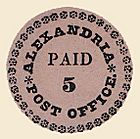
D.C. |

|

|

|
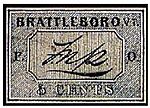
|

|
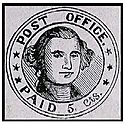
|
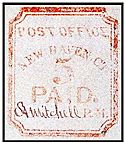
|
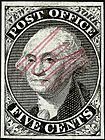
|

|

|
How These Stamps Were Made
The provisional stamps looked very different from each other. The ways they were made also varied a lot.
- Printed from Engraving Plates: Five towns used engraving plates to print their stamps in sheets.
- New York: Used a steel plate to print 40 stamps at a time.
- Baltimore: Printed 12 stamps per plate (nine 5¢ and three 10¢ stamps). Baltimore also used special handstamps to put a signature on envelopes.
- Brattleboro: Used a copper plate to print 10 stamps.
- Providence: Used a copper plate to print 12 stamps (eleven 5¢ and one 10¢ stamp).
- St. Louis: Used a copper plate to print six stamps (three 5¢ and three 10¢ stamps). Later, this plate was changed to make one 5¢, three 10¢, and two 20¢ stamps.
- Typeset Stamps: Two towns used a typesetting method, like arranging individual letters for printing.
- Alexandria: Made two different stamps this way.
- Boscawen: Also used typesetting.
- Other Methods:
- Millbury: Its stamp was printed from a woodcut, like a carved wooden block.
- New Haven and Lockport: Their stamps were made by handstamping, meaning they were pressed onto paper one by one.
- Annapolis: This provisional was an "indicia," which means it was printed directly onto an envelope, not as a separate stamp.
The Rarest Provisional Stamps
Some of these provisional stamps are extremely rare today. Only one copy of the Boscawen and Lockport stamps is known to exist. The Alexandria "Blue Boy" stamp is also unique because it's the only one printed on blue paper. Only six other Alexandria provisional stamps are known, and they are on buff-colored (light brown) paper.
Other very rare stamps include:
- Annapolis: Only 2 copies exist.
- New Haven: Only 11 copies exist.
- Millbury: Only 19 copies exist.
- Baltimore 10¢ stamps: Only 7 copies are known.
Even though 500 Brattleboro stamps were made, only 52 are known today. Providence printed many more, at least 5,500 5¢ stamps and 500 10¢ stamps. St. Louis produced about 9,000 provisional stamps in total. The New York provisional stamps were made in the largest quantity by far, with 143,600 stamps delivered to the New York Post Office.
The End of Provisional Stamps
On July 1, 1847, the United States government finally introduced its own national postage stamps. These new stamps looked very similar to the New York Postmaster's provisional stamp. This isn't a surprise, because the same company in New York designed and printed both!
Once the national stamps were available, the local provisional stamps were no longer needed. However, these early stamps played an important role. They helped people get used to the idea of buying stamps and paying for their mail before sending it.


